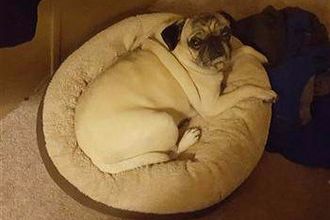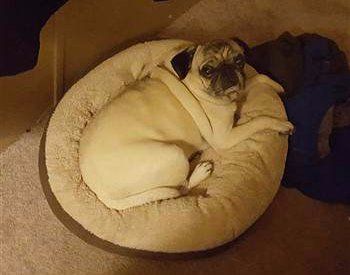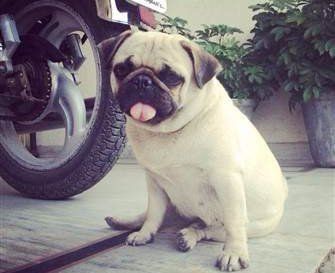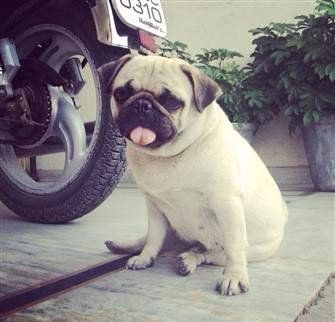Arthritis

Pug Dog Arthritis
Overview
Many Pug dogs end up with arthritis when older (7, 8 years old and up), so it's important to know what this is, how to prevent it, signs of this & treatment. If you take note of this issue now, you may possibly save your Pug a lot of discomfort and pain.
With the most common form of arthritis (osteoarthritis also known as degenerative joint disease) a dog’s joints become inflamed and painful. It is caused by smooth cartilage breaking down and no longer properly protecting bones.
There are 4 types of arthritis with canines:
• Osteoarthritis – this is the most common form, if your Pug dog has arthritis, most likely it is Osteoarthritis
• Immune-mediated
• Infective
• Idiopathic (where the cause is unknown)
Causes of Arthritis in Dogs
1) An injury
- Most commonly to a ligament. Pug dogs that have had luxating patella or hip dysplasia are very prone to develop arthritis in those areas (knees or hips).
2) Obesity –Pugs are prone to weight gain and particularly some older adults and seniors may carry a few too many pounds, especially if they have become sedentary. The more weight
that’s on a joint, the more stressed the joint becomes, and the more likely it will wear down and be damaged.
3) Genetics -
The joints may be genetically weakened or unsteady as a dog grows. It also may be caused by improper bone development.


Chloe at 6 months old
Photo courtesy of owner Sue M.
The Symptoms
• Steady onset of weakness in one or more limb.
• Signs of fatigue - A dog will not want to go for walks, etc.
• Stiffness – A dog will show signs of difficultly in rising from a down position, walking stairs, etc. This is usually worse in the morning and may improve as the day goes.
• Joints may be swollen.
• Pain –Many dog owners will not be able to know that their dog is in pain from arthritis until it has progressed. When a dog is in pain or not feeling well, there will be behavioral changes – the dog may often retreat to be alone or have less of a ‘zesty’ personality.
Prevention
For those who have Pug dogs with former injuries to the knee(s), hips or other areas, owners should be on high alert as the Pug dog grows older. In some cases, arthritis due to former injury can start to set in as soon as 1 or 2 years afterward. Those with
senior Pug dogs (8 years and up) should also be on high alert.
While you cannot completely control if your Pug dog develops arthritis, there are some things that you can do to try and prevent this:
• Keep your Pug dog at a healthy weight
– It’s not uncommon for owners to be so used to seeing their dog each day that they do not notice weight gains, especially when a Pug dog transitions from adult to senior. This breed is prone to having an extra pound or two in the stomach area. Keep yearly vet checkups and additionally you can weigh your Pug dog at home by stepping on the scale yourself and then while holding your dog and subtracting the difference.
• Keep your Pug dog on a daily routine of exercise –
This is so important not only for arthritis issues but for overall health. The goal will be to provide daily exercise
via walking at what is considered a brisk pace for your Pug dog. One walk per day is good and two are great. You’ll want to have your Pug dog walk energetically but without overdoing it, as you don’t want to stress the body. Remember to follow hot weather and cold weather guidelines.
• Limit actions that can cause injury
- Certain actions such as jumping from too high of a height can cause injury. If your Pug dog has a habit of leaping off the sofa, your bed or another favorite spot, it is suggested to place canine steps or a ramp so that the body is not jarred when jumping down.
Another thing to try to prevent is tripping down the stairs (we can’t even count the number of owners who have fallen down a staircase - often along with a Pug dog - because the dog was sitting up at the top and both slid down). Use gates for certain ‘accident prone’ areas if it makes sense to do so.
• Supplements
- There are several supplements
that can help to keep a dog’s joints healthy. While no amount of any supplement can correct structural damage to a dog’s joints, Glucosamine and Omega 3 can decrease inflammation, improve the body’s ability to repair and strengthen tissues and increase mobility.


Dupree, 7 years old
Photo courtesy of owners Jamie Baity & Brandon Olson
How This is Diagnosed
• X-rays are currently the best method to access the severity of arthritis in dogs
• Joint fluid may be collected and analyzed
Treatment
• Anti-inflammatory and pain medications - NSAIDs and steroids are often given and can help to control pain and swelling. These will be prescribed by your dog’s veterinarian. For long-term use, dosing is often low to prevent negative side effects and for that reason, other treatment options shown ahead are often incorporated into a treatment plan.
• Supplements
- As mentioned earlier under ‘Prevention’, Glucosamine and Omega 3 can decrease inflammation, improve the body’s ability to repair and strengthen tissues and increase mobility.
• Acupuncture
- This may help with pain management and is catching on as an alternative treatment for many canine health issues. Most canine acupuncturists will use lavender oils and soft lighting to help a dog relax. Then tiny needles are inserted just barely below the skin
into key points of the dog’s body; most dogs tolerate this well. A session can last from 5 to 20 minutes. Many owners report that this does help their dogs.


Browny, 2 and 1/2 years old
Photo couresty of owner Jatinder Singh
• Alternative medicine for canines
–Prolotherapy is one of the newest nonsurgical trends in veterinary medicine. It is a nonsurgical treatment which stimulates healing. This involves regular injections of dextrose and other substances, such as lidocaine and vitamin B12, to stimulate cell growth and strengthen joint tissue.
• Steps and ramps -
Climbing up on and then coming down from beds, sofas, chairs and other furniture can be hard for a dog with arthritis. Steps or ramps for dogs can be a great help.
• A proper orthopedic dog bed-
Just lying down on the floor can cause discomfort for a dog that has arthritis. A quality orthopedic bed should be placed in areas where a dog usually rests or sleeps - you may need two; one for his normal sleeping area and one in the family room or living room.
• Exercise- When a dog is feeling stiff from arthritis, the worse thing for him is to stay house-bound; it only exasperates the problem. With your vet’s ‘okay’ one or two ‘easy’ walks per day will help a Pug dog loosen up and feel better.
You May Also Like:
Pug Dog Smells
- Sometimes this breed can get a funny odor on him. Learn why this can happen and steps to take that will make your Pug smell more pleasant.
How to Discipline a Pug
- Pugs have quite amusing personalities, but it's not funny if your dog never listens to you. Learn the best way to show him right from wrong, for a well-behaved Pug.
PetPugDog.com Copyright 2019. All rights reserved. Privacy Policy
We are a participant in the Amazon Services LLC Associates Program, an affiliate advertising program designed to provide a means for us to earn fees by linking to Amazon.com and affiliated sites.

